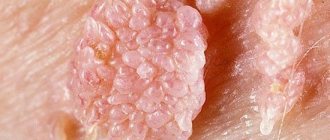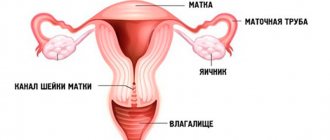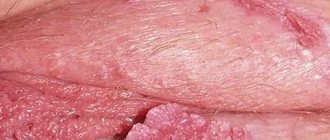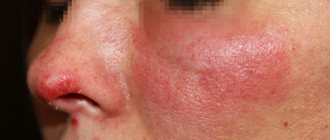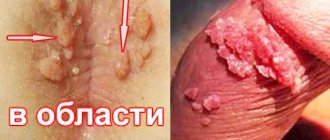Perianal condylomas are growths on the skin in the form of papillae, which are located in the anal folds and around the anus. They can be single or form large foci. Despite their apparent harmlessness, these tumors pose a danger to human health. Their appearance is caused by the activity of the human papillomavirus, and under certain conditions, condylomas can cause squamous cell carcinoma.
Of the 100,000 residents of St. Petersburg, 165 people are infected with HPV subtypes that provoke the formation of perianal condylomas.
How does the virus enter the body?
The content of the article
The main route of infection is sexual. Moreover, regardless of the form of sexual contact - anal, vaginal or oral. A condom reduces the risk of infection, but it is not a panacea.
With a much lower probability, HPV can enter the body through contact and household contact - through touching, hugging, personal hygiene products, manicure tools, etc. Most often, danger awaits in public places - bathhouse, swimming pool, sauna, bus, etc.
The presence of damage and microcracks on the skin favors infection. A vertical route of infection is also possible - from mother to child. The virus can be transmitted to an infant during fetal development or when passing through the birth canal.
Treatment of genital warts
The disease is treated by dermatologists and venereologists.
The doctor must determine exactly whether the growth is genital warts or a sign of another disease
Genital warts must be differentiated from condylomas lata, characteristic of secondary syphilis.
In addition, diseases such as molluscum contagiosum and lichen planus have similar manifestations.
Diagnosing genital warts is not difficult.
This is carried out on the basis of patient complaints, external examination and tests.
The specialist examines the condition of the patient’s skin and mucous membranes.
If necessary, a test is done with 5% acetic acid.
To differentiate condyloma from other growths, take a cotton swab or napkin.
They are moistened with acetic acid and applied to the affected area.
If the neoplasm is a condyloma, after five to ten minutes it becomes whitish in color.
Detection of genital warts is a reason to get tested for syphilis and HIV.
If a specialist suspects the possibility of cancer, a biopsy may be prescribed.
Removing growths does not reduce the risk of cervical cancer.
Remember! If a woman has previously been diagnosed with genital warts, she needs to visit a doctor every year.
It is necessary to regularly take smears from the cervical canal for cytology.
This will help stop the cancer process in time.
Reasons for the appearance of formations
The presence of HPV in the body does not guarantee the development of its clinical manifestations - the appearance of growths. It may remain in standby mode for a long time until favorable conditions occur. Activation of the virus is associated primarily with weakened immunity. This condition is provoked by both environmental conditions and the presence of various diseases.
Human papillomavirus
Lifestyle reasons:
- stress and nervous tension;
- disrupted daily routine;
- unbalanced and unhealthy diet;
- presence of bad habits – smoking, drinking alcohol and drugs;
- avitaminosis;
- long-term use of cytostatics, non-steroidal anti-inflammatory drugs, antibiotics;
- unfavorable environmental conditions;
- excessive mental and physical stress;
- sedentary lifestyle;
- hypothermia, overheating.
Causes associated with the presence of diseases:
- acute respiratory infections, acute respiratory viral infections, influenza;
- HIV AIDS;
- herpes type 2;
- oncology;
- endocrine system disorders;
- anorexia;
- chronic anemia, etc.
Weak immune resistance can also be inherited.
Why do genital warts recur?
Even if treatment is carried out on time, it does not guarantee against relapse.
The virus can become inactive, but remain in the body.
The reappearance of growths often occurs due to a decrease in protective mechanisms.
Decreased immunity causes the process to spread to intimate places.
When infected with the immunodeficiency virus, genital warts grow faster.
With this disease, giant colonies may appear.
Treatment of patients with HIV requires special experience from the doctor, usually it is surgical.
At the second stage, liquid nitrogen removal technology is used.
How to distinguish papilloma from condyloma
Knowing the difference between papilloma and condyloma is necessary to determine further actions. While some can remain on the body throughout life and cause only cosmetic discomfort, others carry the risk of malignant degeneration.
| Index | Papilloma | Condyloma |
| Structure | Homogeneous | Heterogeneous, small, papillary |
| Form | Round or oval, located on a soft stem | Arbitrary, located in clusters, in the form of ridges. Characterized by a narrowing from the stem to the end |
| Size | Up to 10 mm. As a result of traumatic exposure, it may increase by 2-15 mm. | Also capable of growing |
| Color | Weak or intense pigmentation | Virtually no different in color from surrounding tissues |
| Localization | Preferably on the skin | On the mucous membranes, mainly of the urogenital area; on skin folds subject to friction from clothing |
| Peculiarities | Causes aesthetic discomfort. Rarely inflamed, usually only due to injury | It often becomes inflamed and infected. Possible ulceration of the body of the growth, pain |
| Main route of infection | Contact and household | Sexual |
| Exciter type | Typically 2, 7 and 28 strains | 6, 11, 16, 18, 39, 54, 56, 73 strains |
| Risk of malignancy | No | Yes |
Condylomas in women
For those who do not yet know, intimate condylomas are warty, papillary growths on the mucous membrane and skin of the genitals. Caused by the human papilloma virus - HPV, they are more common in adults, regardless of the presence or absence of sexual intercourse, as well as in children, adolescents and virgin girls.
In women, intimate condylomas are most often seen by the gynecologist during an external examination of the genital organs. Although it is not uncommon for small genital warts to be undetected due to insufficient physician care. When a certain size is reached, the growths on the labia begin to be felt by the woman herself, which manifests itself in the form of a vague feeling of the presence of “something extra” between her legs.
Where do condylomas grow most often in women:
- labia,
- Vaginal walls,
- Hymen,
- Entrance to the vagina
- Cervix,
- Anus (usually during anal intercourse),
- Urethra, clitoral area.
A very common place for intimate condylomas to occur is the skin around the anus. In women, this place is often injured during anal sex, the use of rough toilet paper, and some diseases of the anus, so condylomas from the external opening of the anus quickly spread deep into the anal canal through microtrauma. In a similar way, papillomas can also occur in those girls who, wanting to remain virgins, allow sexual intercourse in the rectum. Using a condom during anal sex cannot always protect against infection - HPV can penetrate through the micropores of the product, and the product itself can break due to excessive stress due to the relative narrowness of the anus. It is best to remove condylomas around the anus using the radio wave method in order to minimize the impact on sensitive areas.
Infection with condylomas
If you have been diagnosed with genital condylomatosis or HPV carrier status, don’t be surprised! The presence of this virus in the body is a more expected thing in gynecology than its absence, since it is quite easily transmitted. The asymptomatic course is the reason that papillomas in many cases are an “accidental finding” during an examination by a gynecologist. In this case, it is difficult to accurately determine the route of HPV infection and the duration of the disease.
The virus that causes condyloma lives and manifests itself on the skin and mucous membranes and is transmitted from these areas by touching them. Thus, HPV and intimate papillomas not a disease transmitted exclusively through sexual contact! Yes, of course, sexual intercourse (vaginal, anal) is also a method of transmission, but not the only one: it could also enter the body through everyday means. Therefore, the lack of experience in sexual relations ☛ does not guarantee virgin girls the absence of HPV and genital warts. Therefore, it is important for all representatives of the fair sex from the age of 16 to regularly undergo preventive examinations with a gynecologist and at least have smears for flora.
Photos of condylomas in women
| Intimate papillomas | Vaginal condylomas | Condylomas on the labia |
| Papillomas of the hymen and urethra | Papillomas of the labia minora | Growths on the labia |
Do you want to be checked for intimate warts? Do you want to see everything with your own eyes, just as a gynecologist sees it? We invite you to do a video colposcopy!
Do condylomas need to be removed?
Cauterization of condylomas in intimate places (vagina, cervix, urethra, anus and anal canal, labia, etc.) is a mandatory procedure in gynecology. As well as preliminary diagnosis of carriage - tests for HPV infection in the body. If it is detected, simultaneously with the elimination of all formations, it is necessary to treat the virus. Only in this way can one prevent the progression of the process, the spread of papillomas to other parts of the body, transmission to a sexual partner or family members, and infection of the newborn during childbirth.
And, in the end, for a girl to wear and not remove warts on the genitals and various growths on the labia minora is simply unaesthetic.
Reviews about genital wart removal in the clinic
1. Recently discovered HPV and warts on the labia. Growths in the intimate area appeared several weeks ago. Where is the best place to remove condylomas in Moscow, by what method, so as not to hurt and is effective, I knew firsthand, because... two of my friends went to this clinic. I would like to note the high level of service and professionalism of the gynecologist who worked with me, namely Victoria Borisovna Irmiyaeva. I also liked the conditions at the clinic! I made an appointment through their website and was accepted almost on time. They looked at everyone, took tests, and explained my further actions. After receiving the results, I came to the center to have condylomas cauterized, and during colposcopy the doctor also found one on the cervix, and they are known to be the most dangerous... They removed everything at once, with an injection, it didn’t hurt, I only groaned once) In general, very attentive staff, nice nurses. I have already and will continue to recommend your center to all my friends and acquaintances. Thank you! — Maria, 29 years old, Moscow
2. I tried to remove papillomas in intimate places and in the urethra 2 times, each time they grew back. I was tired of self-torture and decided to go to another center. I found positive reviews on the Internet about the removal of condylomas, which is carried out by this specialized clinic on Kutuzovsky Prospekt. I would like to express my deep gratitude to the gynecologist Bezyuk Laura Valentinovna, who devoted a lot of attention and time to solving my problem. It was only from her that I realized that before I had not carried out the treatment quite correctly, i.e. I simply burned out the condylomas, but did not get tested for viruses, and this is important. After all, if you do not get tested for HPV and do not treat it if it is present, then the papillomas will return again. In my case this was the case. But this time we did everything right, underwent treatment for HPV (types 33 and 18), removed condyloma in the urethra and there were many around. The doctor did everything with pain relief, I didn’t feel anything, only then there was slight discomfort for several days. Thanks for your help! — Sabina R., 31 years old, Moscow
3. There were a few condylomas in the intimate area (near the clitoris). Cauterization with Solcoderm, done by the doctor at this clinic, helped the first time. After a week, everything was practically healed and now there is no longer a trace left. Thank you to the doctor and all the staff! — Olga, 21 years old, Moscow. region
Here you can see all reviews about gynecologists.
How to cure
To date, there is not a single proven treatment for HPV in the world.
The tactics for combating papillomas and condylomas are as follows:
- removal of formation;
- antiviral therapy – to suppress the activity of the virus;
- immunomodulatory therapy – to improve the functioning of the immune system.
To get rid of the growth, various methods are used:
- laser removal;
- cryodestruction;
- radio wave exposure;
- electrocoagulation;
- chemical removal;
- traditional surgery.
The choice of method is made by the doctor depending on the type of formation, its location, size, etc.
Symptoms and signs of condylomas
In most cases, condylomas are localized on the surface of the genital organs. Growths belong to the group of benign neoplasms that have a risk of degenerating into malignant ones. About three hundred million people are infected around the world. Women are more likely to suffer from manifestations of the virus, while men remain sources of infection. What condylomas look like depends on the specific type of HPV.
If we talk about symptoms, the disease may not manifest itself for a long time. As soon as changes occur in the body that reduce a person’s immune barriers, condylomas begin to cause obvious discomfort. It manifests itself in:
- mild itching;
- redness of the skin;
- formation of small tubercles.
The growths gradually grow and take the form of a papule, spot or cockscomb. The number of genital warts may increase, and the itching may become stronger.
Upon visual examination, growths are often confused with papules, papillomas or molluscum contagiosum. To make a correct and accurate diagnosis, an examination by a specialist and tests are required.
Are you experiencing symptoms of condylomas?
Only a doctor can accurately diagnose the disease. Don't delay your consultation - call
Laser removal
This is a modern method of excision of formation, which has become widespread.
Its popularity is due to its advantages:
- painlessness;
- low-injury;
- bloodlessness;
- speed of the procedure;
- minimal risk of infection;
- short rehabilitation period;
- no scars.
Thanks to the precision of the laser beam, it is possible to remove growths even in particularly sensitive areas, such as the intimate area, eyelid, etc.
Cryodestruction
This removal method is only used for skin tags. It consists of a short-term effect on the formation of liquid nitrogen. Pathological tissues are destroyed by flash freezing.
Cryodestruction
The advantages of cryodestruction include easy tolerance by the patient, no need for anesthesia and no risk of scar formation. Disadvantages are difficulty in controlling the depth of impact and a longer rehabilitation period.
Factors that increase the risk of developing condylomas
HPV infections themselves do not cause malignant transformation of the affected cells. Cofactors play a significant role - ultraviolet radiation, smoking, folic acid deficiency, pregnancy, immunodeficiency, Chlamydia trachomatis infection, herpes virus (HSV2).
Patients undergoing immunosuppressive therapy and patients with defective cellular immunity, especially those infected with HIV, have higher rates of HPV infections and respond poorly to treatment.
On the other hand, in immunocompetent individuals there is a clear tendency for spontaneous recovery. It is highly likely that hormonal contraceptives also act as a cofactor and can enhance the cancer process.
The significant role of coccinogens is indicated by the significant time interval between the peak of HPV infections (18–25 years) and the peak incidence of cervical cancer (45–50 years). The process of tumor transformation is very slow and requires the presence of additional favorable factors.
The epidemiological relationship between infection with oncogenic types of HPV and the development of neoplasms of the genital organs is very high and in the case of cervical cancer is 95-99.7%, and in the case of anal canal cancer - 88%. Cervical cancer is the second most common malignancy in women. Every year there are 500 thousand new cases of the disease, from which 50% of sick women die.
Electrocoagulation
The method is aimed at cauterizing the growth using electric current. With its help, you can remove papillomas and condylomas on any part of the body, including delicate ones. However, for the urogenital area and eyelids, it is better to give preference to methods that are less painful.
Electrocoagulator
The formation is destroyed under the influence of high temperature, due to which the surrounding tissues are also damaged. In addition, patients note poor healing, and sometimes scarring and relapses. The advantages of this type of removal are sterility, bloodlessness, the ability to adjust the current strength and control the depth of exposure.
Clinical picture of condyloma
Condyloma is a benign change caused by more than 30 low-risk HPV types (most commonly 6 and 11). In men, they are most often found in the external genitalia (penis, foreskin) or in the anal area.
There are several forms, the most common of which are:
- genital warts (condyloma accuminata);
- flat warts (condyloma plan);
- giant Buschke-Levenshtein condyloma;
- bowenoid papulosis;
- genital wart (Condyloma accuminata).
The neoplasm appears soft, pink, with a rough surface and outwardly similar in shape to cauliflower. Less commonly, they can fuse together and form clusters larger than 6 cm. They can appear at any age, but usually occur in young, sexually active people aged 20 to 40 years.
In men, they are mainly located at the tip of the penis or in the anal area, but they can also be found inside the urethra or in the groin area.
Particular attention should be paid to condylomas in children, as they can develop as a consequence of sexual abuse.
Folk remedies
On the Internet you can find many recipes and techniques for removing papillomas and condylomas. However, you should not self-medicate. Only a doctor can safely and effectively get rid of the problem. Any attempts to bandage the formation with thread, cauterize it with celandine juice and other popular folk methods can provoke complications.
ONLINE REGISTRATION at the DIANA clinic
You can sign up by calling the toll-free phone number 8-800-707-15-60 or filling out the contact form. In this case, we will contact you ourselves.
How to treat anal condylomas
To remove genital warts, doctors use concentrated solutions of acids, alkalis, salts, hydrogen peroxide, solutions of hingamine and quinine, preparations based on lactic and salicylic acids, nitric and acetic acid, celandine and thuja juices. Solcoderm is especially effective. This is an aqueous solution, the active ingredient of which is the reaction products of acetic, lactic and oxalic acids, as well as metal ions with nitric acid. When solcoderm is applied topically to the affected areas, intravital fixation occurs (the structure of the neoplasm is preserved). Subsequently, the pathologically altered tissues become mummified. Healing occurs under the scab. This eliminates the formation of an open wound surface.
Podophyllotoxin is a cytotoxic drug. The drug is available in the form of 0.25, 0.3 and 0.5% solutions, as well as in the form of 0.15, 0.3 and 0.5% cream. It is more suitable for the treatment of genital warts, but is ineffective for the treatment of anal warts.
Doctors at the Yusupov Hospital prescribe to patients a 0.5% solution (condilin) registered in the Russian Federation or a 0.15% cream – Vartek. Patients can safely self-administer the drug. Some patients develop side effects in the form of local inflammatory reactions, skin redness, burning, itching, and soreness.
DNA inhibitors have a great therapeutic effect. 5-Fluorouracil is a pyrimidine antagonist. Proctologists prescribe it for the treatment of anal warts in the form of a 5% cream. Despite the fairly high effectiveness, availability and low cost of the drug, the use of 5-Fluorouracil in widespread practice is limited due to the high incidence of side effects. The drug is also contraindicated during pregnancy and breastfeeding. The cream of the required concentration is prepared by prescription in pharmacies according to a prescription prescribed by a doctor.
To prevent the re-formation of anal genital warts, proctologists prescribe interferon or its inducers. Immune drugs can increase the effectiveness of treatment and reduce the frequency of relapses. Combined immunotherapy is used in the treatment of persistent, difficult-to-treat anal genital warts. Proctologists use various techniques. Immune drugs are combined with laser therapy, cryodestruction, electrocoagulation, and solcoderm. Proctologists at the Yusupov Hospital use interferons registered in the Russian Federation: Viferon, Reaferon, Kipferon, Intron A, Realdron. Doctors prefer recombinant rather than human interferons.
For the treatment of anal condylomas, a low molecular weight derivative of imihidazoquinolinamine, imiquimod, is used topically in the form of a 5% cream 3 times a week or daily at night until the rash completely disappears. After using the drug, redness, swelling of the perianal area, and erosion sometimes occur.
Doctors influence antiviral immunity using an antiviral immunity activator - Immunomax. This is a herbal preparation that is available in the form of a lyophilized powder of 200 units in vials for injection. Proctologists remove anal condylomas from patients using one of the destructive methods or using Solcoderm and at the same time prescribe intramuscular injections of Immunomax. In 68% of patients, at the end of treatment, there is no re-formation of genital anal warts, and after additional destruction sessions, the effectiveness of combination therapy reaches 98%.
Isoprinosine is an immunomodulator that stimulates the body's antiviral defense. It normalizes deficiency or impaired function of cellular immunity. In addition to immunotropic, Isoprinosine has a direct antiviral effect. The drug is successfully used for the treatment of anal warts.



